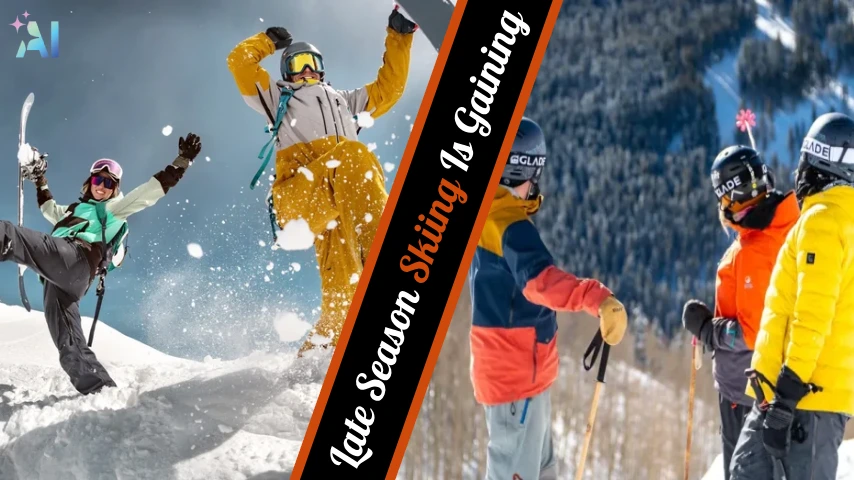Late season skiing is becoming the new hot trend in winter sports. More and more people are discovering the joys of hitting the slopes when spring is in the air. But what’s behind this shift? Why are skiers trading in their mittens for sunglasses and swapping peak season crowds for laid-back spring vibes? Let’s dive into the reasons why late season skiing is gaining popularity and explore the unique experiences it offers.
Why Late Season Skiing Is Gaining Popularity
Late season skiing refers to skiing that takes place towards the end of the traditional ski season, typically from mid-March through April and sometimes even into May. It’s a time when winter’s grip starts to loosen, but the mountains still hold onto their snowy treasures. This trend is catching on fast, with skiers of all levels flocking to the slopes for a different kind of alpine adventure.
Favorable Weather Conditions
One of the biggest draws of late season skiing is the weather. As winter fades into spring, the days get longer and the temperatures start to climb. This means you can say goodbye to those bone-chilling lift rides and hello to comfortable skiing conditions.
Warmer temperatures make for a more enjoyable experience on the slopes. You can shed those bulky layers and enjoy the freedom of skiing in lighter gear. Plus, the longer days mean more time on the mountain. Imagine carving turns as the sun sets, painting the snow in golden hues – it’s a magical experience that early season skiers often miss out on.
But it’s not just about comfort. The improved visibility during late season is a game-changer. Clear skies and bright sunshine are more common, offering breathtaking views of the surrounding landscape. This enhanced visibility also makes for safer skiing conditions, especially for those who are still finding their snow legs.
Cost-Effective Vacations
Let’s face it, skiing can be expensive. But late season skiing offers a wallet-friendly alternative to peak season trips. As the crowds thin out, many resorts drop their prices to attract visitors. You’ll find lower rates on lift tickets and accommodations, making that dream ski vacation suddenly more affordable.
And it’s not just about saving on the basics. Late season is prime time for end-of-season sales on ski gear and equipment. If you’ve been eyeing that new pair of skis or a fancy jacket, this is your chance to snag them at a fraction of the cost. It’s a win-win – you get to enjoy your ski trip and come home with some new gear without breaking the bank.
Less Crowded Slopes
Nothing puts a damper on a ski day quite like long lift lines and crowded slopes. But come late season, these frustrations melt away like spring snow. With fewer people on the mountain, you’ll spend more time skiing and less time waiting.
Shorter lift lines mean more runs per day. You can really make the most of your time on the mountain when you’re not stuck in a queue. And once you’re on the slopes, you’ll have more space to spread out and enjoy your turns without worrying about colliding with other skiers.
This relaxed atmosphere is especially beneficial for beginners. Learning to ski can be intimidating, but with fewer people around, novice skiers can take their time and practice without feeling rushed or watched. It’s a more laid-back environment that takes some of the pressure off and allows for a more enjoyable learning experience.
Snow Quality and Coverage
Now, you might be wondering about the snow. Isn’t spring skiing just a slushy mess? Not necessarily! Late season snow can actually offer some fantastic skiing conditions.
While it’s true that the snow is different from the powdery stuff you might find mid-winter, spring snow has its own charm. As temperatures fluctuate between day and night, the snow goes through a freeze-thaw cycle. This creates a phenomenon known as “corn snow” – a smooth, granular surface that’s incredibly fun to ski on.
But what about coverage? Thanks to advancements in snowmaking technology, many resorts can maintain good snow coverage well into spring. Modern snow guns can produce snow even in warmer temperatures, ensuring that key runs stay open longer. Plus, the base layer built up over the winter months provides a solid foundation for spring skiing.
Extended Ski Seasons
The popularity of late season skiing hasn’t gone unnoticed by ski resorts. Many are now extending their seasons to cater to this growing trend. It’s not uncommon to find resorts staying open well into April or even May, especially in high-altitude areas.
Speaking of high altitudes, some destinations offer year-round skiing opportunities. Places like Zermatt in Switzerland or Hintertux in Austria have glaciers that allow for skiing even in the height of summer. These spots are becoming increasingly popular for those who just can’t get enough of the snow, no matter the season.
Why Are Beginners Drawn to Late Season Skiing?
- Easier learning conditions
Late season skiing is particularly appealing to beginners, and for good reason. The softer snow conditions typical of spring skiing are more forgiving for those still mastering their technique. Falls are less painful, and turns are easier to initiate in the softer snow.
- More patient and relaxed environment
The overall vibe on the mountain is more relaxed during the late season. With fewer people around, instructors can often give more personalized attention to their students. Fellow skiers tend to be more patient and understanding, creating a supportive atmosphere for those still learning the ropes.
Environmental Considerations
While late season skiing has many benefits, it’s important to consider the environmental impact. Climate change is affecting ski seasons worldwide, with some areas seeing shorter winters and less predictable snowfall.
However, the shift towards late season skiing could actually be part of a more sustainable approach to the sport. By extending the season, resorts can spread out visitor numbers, reducing the intense pressure on resources during peak times. Many resorts are also investing in eco-friendly snowmaking technologies and implementing sustainability practices to mitigate their environmental impact.
Popular Late Season Skiing Destinations
| Resort | Country | Typical Closing Date |
|---|---|---|
| Zermatt | Switzerland | Year-round |
| Whistler | Canada | Late May |
| Tignes | France | Early May |
These destinations are just a few examples of places where you can enjoy excellent late season skiing. Each offers unique experiences and stunning scenery, proving that great skiing doesn’t have to end when winter does.
What About the Après-Ski Scene?
Late season skiing isn’t just about what happens on the slopes – the après-ski scene takes on a whole new character in spring. Many resorts host unique spring events and activities, from outdoor concerts to fun competitions like pond skimming.
As temperatures rise, outdoor terraces come alive. Picture yourself relaxing in a sun-drenched beer garden after a day on the slopes, swapping stories with fellow skiers as you soak up the mountain views. It’s a different vibe from the cozy fireside gatherings of midwinter, but equally enjoyable in its own right.
Conclusion
Late season skiing is more than just a trend – it’s a different way to experience the mountains. From the comfortable weather and cost savings to the relaxed atmosphere and unique snow conditions, there are plenty of reasons why more people are choosing to hit the slopes in spring.
As we look to the future, it’s likely that late season skiing will continue to grow in popularity. With resorts extending their seasons and investing in technologies to ensure good snow conditions, the opportunities for spring skiing are only set to increase.
So, whether you’re a seasoned pro looking for a new challenge or a beginner ready to take your first turns, consider giving late season skiing a try. You might just find that the best skiing of the year happens when winter is on its way out and spring is in the air. After all, there’s something special about carving turns under the warm spring sun, surrounded by blooming alpine meadows. It’s a unique blend of winter sport and spring renewal that’s hard to beat.





